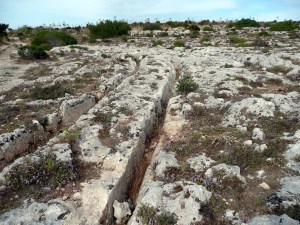
In our papers looking at early wagonways and railways, the Diolkos on the Isthmus of Corinth in Greece, was identified as probably the first purpose-built railway in the world (if you define a railway as a set of tracks that guide wheeled vehicles). This blog takes a close look at this fascinating construction project.
Unlike most other projects at the time of its construction, the Diolkos has three unique characteristics:
- Its purpose was commercial – most other projects of its time were built for the purpose of either religious celebration, military necessity, or royal ego-trips.
- The construction had to be completed before any value could be derived from the work. You either transported a ship across the Isthmus, or you did not!
- There was no option for incremental development. There may well have been earlier trackways for moving goods from shore to shore using pack animals or wagons, and using logs as wooden rollers to move ships was feasible but it is a big jump from these technologies to a ship transporter system.
These characteristics make the decision of the Corinthians who commissioned and constructed the project the first commercial project sponsors I have been able to identify. And, the 650+ years of operation of the Diolkos suggest they got their decision correct.
The Diolkos (pass via machinery) was a paved trackway, variously measured to be between 6 to 8.5 km long, that enabled vessels to be moved overland across the Isthmus of Corinth. It was built to speed up the transfer of goods between the Gulf of Corinth and the Saronic Gulf, although, in times of war, it may also been used as a means of speeding up naval campaigns. The alternative way to reach Athens, and other ports in the Saronic Gulf, from the Gulf of Corinth was for ships to take a nearly 700-kilometer-long detour around the Peloponnese. A journey that was not only long but dangerous. Gale-force winds around Cape Matapan and Cape Maleas often troubled sailors. Whereas, both the Gulf of Corinth and the Saronic Gulf were relatively calm and the narrow strip of land, the Isthmus of Corinth, separating both the water bodies was only 6.4 km wide at its narrowest.

The basic mode of operation for the Diolkos was for a cargo vessel to be unloaded at one end and its cargo carried separately on wagons to the other side of the isthmus, then the ship was loaded onto the Diolkos, and pulled to the other side where it was refloated, then reloaded.
Enough of the trackway remains to show how the system operated. Eastward-bound ships would arrive at the northwestern end of the Diolkos at the current location of Poseidonia in Corinth where there was a stone ramp. They were then pulled up the ramps onto a stout wooden frame, or sledge. Once they were on dry land, the ships were then stripped of their masts and other movables to make them as light as possible. The massive vessels then were turned by winches to line them up with the Diolkos. Next, they would be pulled up another stone ramp to get them onto the wheeled undercarriage. These had large wheels along both sides spaced to fit into the deep grooves cut into the stones of the trackway, which ensured the undercarriage and its burden would stay firmly on track all the way to the other side of the isthmus. Even though the gradient of the road only went up to approximately three percent, it would still have been a feat of engineering and brute strength to move seagoing vessels overland in this way. This process appears to have been improved to some extent in the early 4th century BCE, when it seems that a wooden lifting machine was installed that allowed easier placement of ships on the standing wheeled vehicle.
Excavation and restoration works show us the paving was made of limestone blocks with carved grooves at an axial distance of about 1.50m for the guidance of the wooden wheeled vehicle on which the ships were transported. Engraved letters on some of the paving stones belong to the oldest local alphabet and date the works to the beginning of the 6th century BCE.

At each end of the route, the track continues down to a pier and slipway at the water’s edge.

At the western end, a section of an inclined cobbled pier measuring about 10.00 x 8.00m has been excavated.
In summary, it seems a combination of human and animal power plus great technological know-how allowed the Diolkos to function for over 650 years, from around 600 BCE until the middle of the first century CE. A successful project by any measure!
It also seems the Diolkos served a very similar purpose to the early wagonways and railways developed in England and Europe in the 16th century CE – the efficient movement of goods. This aspect is discussed in The First Railway Projects, you can download this paper and others on early transport projects from: https://mosaicprojects.com.au/PMKI-ZSY-005.php#Process2
But there’s more
The use of groves carved (or worn) into rock to help guide wagons seems to be much older than the Diolkos.
The starting point of this development was wooden sledges that are known to have been used by communities living by hunting and fishing in northern Europe, on the fringes of the Arctic during the late Mesolithic Period from 7000 BCE or earlier.
During the Neolithic, the domestication of cattle, and more particularly the discovery that a castrated bull becomes the docile but very powerful ox, meant that humans could transport heavier loads. This is done at first on larger sledges, which slither adequately over the dry grass of the steppes of southern Russia and on the parched earth of Mesopotamia. In both regions ox-drawn sledges are in use by the 4th millennium BCE. Then from around 3000 BCE the development of wheeled wagons seems to have occurred and spread quickly (or wheeled wagons were developed in multiple locations). These vehicles were 4-wheeled and pulled by people or animals, the image is a depiction of an onager-drawn wagon on the Sumerian “War” panel of the Standard of Ur (c. 2500 BCE).
These early wagons had fixed axles steering was achieved by physical force applied to the side of the wagon (2-wheeled carts and chariots were developed quite a bit later and were linked to the domestication of the horse). As the use of heavy wagons became more commonplace, it seems that where a relatively soft, flat bedrock was close to the surface, wheel ruts started to be worn into the surface, and people found the ruts made guiding their cart easier, the wheels just followed in the groves. From this starting point, it does not need a huge leap of imagination for someone to realize that by carving a starting point into the rock, subsequent use would develop deeper grooves though wear, making the job of guiding a cart progressively easier. This type of ‘cart rut’, can be found in Malta, Greece, Italy, Sicily, Sardinia, Switzerland, Spain, Cyrenaica, Portugal, Azerbaijan and France.
As with most examples, the age and purpose of the Maltese tracks is uncertain with estimates of their origins ranging from c.700 BCE, but with several examples pointing to a Temple Period date c. 3800-2500 BCE. The underlying rock in Malta is weak and when it’s wet it loses about 80 percent of its strength so whether these tracks were carved, or worn into the bedrock, or started by carving then worn deeper, is open to question.
Misrah Ghar il-Kbir (Clapham Junction) – Malta.
These earlier examples suggests the convenience of having guides to help keep carts on the desired track would have been well understood by the time the Diolkos was built. The builders of the Diolkos simply expanded on the concept by making their own ‘bedrock’ by laying paving stones.
The use of fixed (non-steering) axles continues through to the present time. The mine carts of the 13th century, the ‘chaldrons’ used on the NE England wagonways in the 18th century to move coal to the wharfs, through to modern railway freight cars all use fixed axles guided by groves or rails. For more on the history of railways see the papers at: https://mosaicprojects.com.au/PMKI-ZSY-005.php#Process2.
The use of a steerable front axle on wagons is a much later development, dependent on the availability of iron to efficiently manage the high loads at the pivot pin. This was achieved in about 500 B.C. (although some commentators put the date as early as 1500 B.C.) with the production of an axle capable of swiveling about a vertical axis. Such vehicles can be readily detected in accurate drawings because the front wheels had to be small enough in diameter to pass under the floor of the vehicle. The technology did not spread rapidly. There were only a few steerable wagons in fourteenth-century England, and they were not widespread until the seventeenth century.






